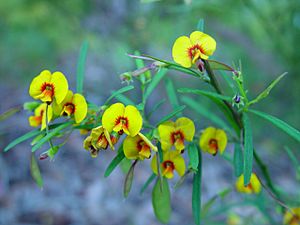Eutaxia parvifolia facts for kids
Quick facts for kids Eutaxia parvifolia |
|
|---|---|
 |
|
| Scientific classification | |
| Genus: |
Eutaxia
|
| Species: |
parvifolia
|
| Synonyms | |
|
|
Eutaxia parvifolia is a type of flowering plant that belongs to the pea family, called Fabaceae. This plant is special because it only grows in the southwestern part of Western Australia. It is a shrub with reddish-brown stems and leaves shaped like an oval or an egg. Its flowers are usually yellow, red, or orange, often with colorful spots or streaks.
Contents
What Does It Look Like?
Eutaxia parvifolia is a shrub that can grow upright or spread out low to the ground. It has many branches and usually reaches a height of 0.2 to 2 meters (about 8 inches to 6.5 feet). Its stems are reddish-brown and smooth.
Leaves and Flowers
The leaves of this plant grow in pairs, one across from the other. They are shaped like an oval or an egg, with the narrower end at the base. These small leaves are about 2.5 to 17 millimeters (0.1 to 0.7 inches) long and 1 to 3 millimeters (0.04 to 0.12 inches) wide. Each leaf has a short stalk, called a petiole, which is about 1 to 3 millimeters long.
The flowers grow one by one where the leaves meet the stem. They are often grouped closely together near the ends of the branches. Each flower sits on a tiny stalk, called a pedicel, which is about 1 to 2.4 millimeters long.
Petals and Blooming Time
The sepals, which are like small leaves protecting the flower bud, are ribbed and have tiny hairs. They are about 4.5 to 7 millimeters long and are joined together at their base. The petals are mostly yellow, red, or orange, and they often have spots, streaks, or blotches of these colors.
Like many pea flowers, it has three main types of petals:
- The "standard" petal stands upright and is about 7.5 to 9 millimeters long.
- The two "wing" petals are about 5.5 to 7.8 millimeters long.
- The "keel" petal encloses the stamens (the parts that produce pollen) and is about 5 to 5.7 millimeters long.
This plant usually blooms from August to December. After flowering, it produces a fruit that is about 4.5 to 7 millimeters long and 2 to 3.5 millimeters wide.
How It Was Named
The plant Eutaxia parvifolia was officially described in 1837 by an English botanist named George Bentham. He wrote about it in a book called Enumeratio plantarum quas in Novae Hollandiae ora austro-occidentali ad fluvium Cygnorum et in sinu Regis Georgii collegit Carolus Liber Baro de Hügel. Bentham based his description on plant samples collected by Charles von Hügel in a place called King George Sound.
The second part of the plant's scientific name, parvifolia, comes from Latin words. "Parvus" means "small," and "folium" means "leaf." So, parvifolia means "small-leaved," which describes its tiny leaves.
Where It Lives
This type of eutaxia plant grows in areas with heathland (open land with small shrubs) and woodland (areas with trees). You can find it in a region stretching between Bolgart, Albany, and the Cape Arid National Park in Western Australia.
Conservation Status
The Government of Western Australia's Department of Parks and Wildlife has classified Eutaxia parvifolia as "not threatened." This means that, for now, there are enough of these plants in the wild, and they are not considered to be in danger of disappearing.

